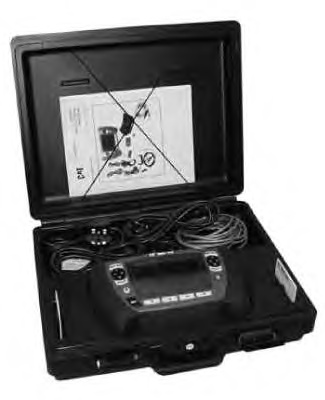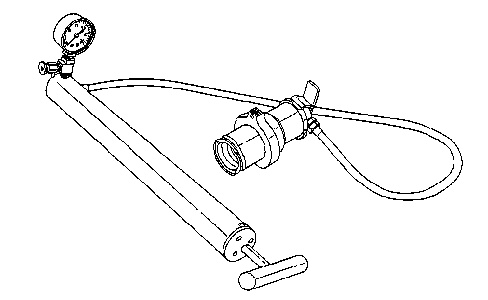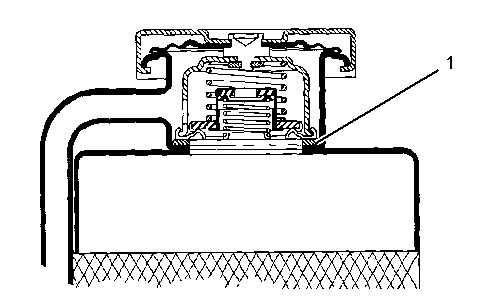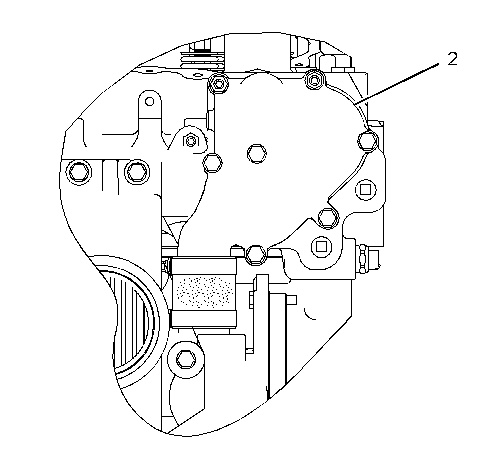This engine has a pressurized cooling system. A pressurized cooling system has two advantages. The cooling system can be operated in a safe manner at a temperature higher than the normal boiling point (steam) of water.
This type of system prevents cavitation in the water pump. Cavitation is the forming of low-pressure bubbles in liquids that are caused by mechanical forces. A pressurized cooling system helps to prevent pockets of air from forming.
|
|
|
|
|
|
| Illustration 1 | g01106438 |
|
Effects of pressure on boiling point of a cooling system |
|
Temperature and pressure work together. When a diagnosis is made of a cooling system problem, both temperature and pressure must be checked. Cooling system pressure affects the cooling system temperature. For an example, refer to Illustration 1. The chart will show the effect of pressure on the boiling point (steam) of water. The chart will also show the effect of height above sea level.
|
Personal injury can result from hot coolant, steam and alkali. At operating temperature, engine coolant is hot and under pressure. The radiator and all lines to heaters or the engine contain hot coolant or steam. Any contact can cause severe burns. Remove filler cap slowly to relieve pressure only when engine is stopped and radiator cap is cool enough to touch with your bare hand. Cooling System Conditioner contains alkali. Avoid contact with skin and eyes. |
The coolant must be at the correct level in order to check the coolant system. The engine must be cold and the engine must not be running.
Slowly loosen the pressure cap in order to relieve the pressure out of the cooling system. Then remove the pressure cap.
The level of the coolant should not be more than 13 mm (0.5 inch) from the bottom of the filler pipe. If the cooling system is equipped with a sight glass, the coolant should be to the proper level in the sight glass.
Tools for Testing the Cooling System
| Required Tools | ||
|---|---|---|
| Part Number | Part Name | Quantity |
| 348-5430 | Digital Thermometer, part of Multi-Tool Gp | 1 |
| 348-5430 | Multi-Tool Gp | 1 |
| 9S-8140 | Pressurizing Pump | 1 |
| 308-7265 | Multitach Tool Gp | 1 |
| 245-5829 | Coolant/Battery Tester Gp | 1 |
|
Making contact with a running engine can cause burns from hot parts and can cause injury from rotating parts. When working on an engine that is running, avoid contact with hot parts and rotating parts. |
The Digital Thermometer is used for the diagnosis of overheating conditions and for the diagnosis of overcooling conditions. This group can be used to check temperatures in several different parts of the cooling system. Refer to the tool Operating Manual, NEHS1087 for the testing procedures.
|
|
|
|
|
|
| Illustration 2 | g02709261 |
|
348-5430 Multi-Tool Gp |
|
| Required Tools | ||
| Part Number | Part Name | Quantity |
| 348-5430 | Multi-Tool Gp | 1 |
| 285-0900 | Blowby Tool Group | 1 |
| NETG5049 | Software License | 1 |
The 348-5430 Multi-Tool Gp is used to check the air flow through the radiator core.
The 308-7265 Multitach Tool Gp, part of the 348-5430 Multi-Tool Gp, is used to check the fan speed for an engine. Refer to the tool Operating Manual for the testing procedure.
|
|
|
|
|
|
| Illustration 3 | g00286369 |
|
9S-8140 Pressurizing Pump |
|
The 9S-8140 Pressurizing Pump is used to pressure test the radiator filler cap. This pressurizing pump is also used to pressure test the cooling system for leaks.
Check the coolant frequently in cold weather for the proper glycol concentration. Use the 245-5829 Coolant/Battery Tester Gp in order to ensure adequate freeze protection. The testers are identical except for the temperature scale. The testers give immediate, accurate readings. The testers can be used for antifreeze and/or coolants that contain ethylene or propylene glycol.
Test and Inspect the Filler Cap
| Required Tool | ||
|---|---|---|
| Part Number | Part Name | Quantity |
| 9S-8140 | Pressurizing Pump | 1 |
One cause for a pressure loss in the cooling system can be a damaged seal on the radiator filler cap.
|
|
|
|
|
|
| Illustration 4 | g01096114 |
|
Cutaway view of a filler cap and radiator (1) Sealing surface of both filler cap and radiator |
|
|
Personal injury can result from hot coolant, steam and alkali. At operating temperature, engine coolant is hot and under pressure. The radiator and all lines to heaters or the engine contain hot coolant or steam. Any contact can cause severe burns. Remove filler cap slowly to relieve pressure only when engine is stopped and radiator cap is cool enough to touch with your bare hand. Cooling System Conditioner contains alkali. Avoid contact with skin and eyes. |
To check for the amount of pressure that opens the filler cap, use the following procedure:
- After the engine cools, carefully loosen the filler cap. Slowly release the pressure from the cooling system. Then, remove the filler cap.
Carefully inspect the filler cap. Look for any damage to the seals and to the sealing surface. Inspect the following components for any foreign substances:
- Filler cap
- Seal
- Surface for seal
Remove any deposits that are found on these items, and remove any material that is found on these items.
- Install the filler cap on the 9S-8140 Pressurizing Pump .
- Look at the gauge for the exact pressure that opens the filler cap.
- Compare the gauge reading with the opening pressure that is listed on the filler cap.
- If the filler cap is damaged, replace the filler cap.
Test the Radiator and the Cooling System for Leaks
| Required Tool | ||
|---|---|---|
| Part Number | Part Name | Quantity |
| 9S-8140 | Pressurizing Pump | 1 |
Use the following procedure in order to check the cooling system for leaks:
- Ensure that the engine is cool. Loosen the filler cap slowly and allow pressure out of the cooling system. Then remove the filler cap from the radiator.
|
Personal injury can result from hot coolant, steam and alkali. At operating temperature, engine coolant is hot and under pressure. The radiator and all lines to heaters or the engine contain hot coolant or steam. Any contact can cause severe burns. Remove filler cap slowly to relieve pressure only when engine is stopped and radiator cap is cool enough to touch with your bare hand. Cooling System Conditioner contains alkali. Avoid contact with skin and eyes. |
- Ensure that the coolant level is above the top of the radiator core.
- Install the 9S-8140 Pressurizing Pump onto the radiator.
- Take the pressure reading on the gauge to 20 kPa (3 psi) more than the pressure on the filler cap.
- Check the radiator for leakage on the outside.
- Check all connection points for leakage, and check the hoses for leakage.
The following conditions exist if the cooling system does not have external leakage:
- You do not observe any outside leakage.
- The pressure reading on the cooling system remains steady after 5 minutes.
The following conditions exist if the cooling system has internal leakage:
- The pressure reading on the cooling system decreases in a 5 minute period.
- You do not observe any outside leakage.
Repair the cooling system, as required.
Test for the Water Temperature Gauge
| Required Tool | ||
|---|---|---|
| Part Number | Part Name | Quantity |
| 348-5430 | Digital Thermometer, Part of Multi-Tool Gp | 1 |
Note: Caterpillar Electronic Technician (ET) can also be used in order to display the engine coolant temperature.
|
Personal injury can result from escaping fluid under pressure. If a pressure indication is shown on the indicator, push the release valve in order to relieve pressure before removing any hose from the radiator. |
|
Making contact with a running engine can cause burns from hot parts and can cause injury from rotating parts. When working on an engine that is running, avoid contact with hot parts and rotating parts. |
Check the accuracy of the water temperature indicator or water temperature sensor if you find either of the following conditions:
- The engine runs at a temperature that is too hot, but a normal temperature is indicated. A loss of coolant is found.
- The engine runs at a normal temperature, but a hot temperature is indicated. No loss of coolant is found.
|
|
|
|
|
|
| Illustration 5 | g01425262 |
|
Typical example (2) Water manifold assembly |
|
Remove a plug from water manifold assembly (2). Install the 348-5430 Digital Thermometer, Part of Multi-Tool Gp into the open port:
Any temperature indicator of known accuracy can also be used to make this check.
Start the engine. Run the engine until the temperature reaches the desired range according to the test thermometer. If necessary, place a cover over part of the radiator in order to cause a restriction of the air flow. The reading on the temperature indicator should agree with the test thermometer within the tolerance range of the water temperature indicator.




